1lumen selects and reviews products personally. We may earn affiliate commissions through our links, which help support our testing.
Natfire SF2 review

Natfire SF2 specifications
| Brand/model | Natfire SF2 |
|---|---|
| LEP | (shine through) |
| Max. Lumens | ? |
| Max. Beam intensity / distance | ? |
| Battery config. | 1*21700 |
| Onboard charging | USB-C |
| Modes | 5 |
| Blinkies | Strobe, SOS |
| Reflector | Aspheric lens |
| Waterproof | IPX5 |
| Review date | April 2022 |
Introduction:
Flashlights have sure come a long way. Just 7 years ago the farthest-throwing flashlights were still using short arc xenon lamps, followed by high-intensity LEDs behind huge aspheric lenses. In 2018 a new type of flashlight was introduced. Made by Chinese manufacturer Weltool, the light was called the Weltool W3. It was a compact light with a 33 mm head that could reach over 180,000 cd, nearly 900 m of throw, which at the time was pretty incredible for something so small. This was thanks to a new light source known as LEP. Short for Laser Excited Phosphor, this turns light from a pumped blue laser into a somewhat-flashlight-like beam with extremely high light intensity and candela figures more akin to LED lights with huge reflectors. Now everyone makes an LEP it seems, but there’s a problem. LEPs are significantly more expensive than LED lights, so they were relegated to the upper-end of the flashlight hierarchy. As of today, the cheapest LEP on 1Lumen is the Lumintop Thor 1, around $100 (on sale), followed by the Richfire SFC-039 that Dave tested in at about $130, followed by the light with no name Nealsgadgets LEP at about $160 Marco tested. Even $130 is a bit steep for some.
In the USA, you can’t sell your body parts, so what’s a guy gotta do to get an LEP around here? This is where I introduce you to Natfire. I had never heard of them, but they make bike lights and cheap LED flashlights, and now they’ve started selling an LEP, the SF2. It promises 1200-1500 meters of throw out of a C8-sized host, which is great for a LED flashlight, but nothing spectacular for an LEP. However, what is pretty special is the price: $150? Nope. $130? Lower. $100? Less than that. Right now, the SF2 sells for under $100 US! Yep, you heard me, a bonafide-LEP for under $100. Well, I’m skeptical because there’s ‘fire’ in the name and we all know what that means. Plus, that low price probably comes with some compromises in other places. I hope it doesn’t live up to that homologous branding reputation, but will the SF2 be an exception to that rule?
Package quality.
The Natfire SF2 came in a decent package. It’s handsome with a Cyansky-like color scheme and retail hang tag. The box was smooshed on its journey from the Orient, and it did a good job protecting the flashlight and accessories. Nothing special, and appropriate for this price range. Here’s what you get:
- Natfire SF2
- Lanyard
- Manual
- Inspection placard
- USB type A to C charging cable
Overall, this is expected in a flashlight of this type and price. It’s RTR (ready-to-run) with everything needed to open the box and get on with it. The accessories are nice and seem to be okay quality, and at this price, accessories are a bit of a luxury.
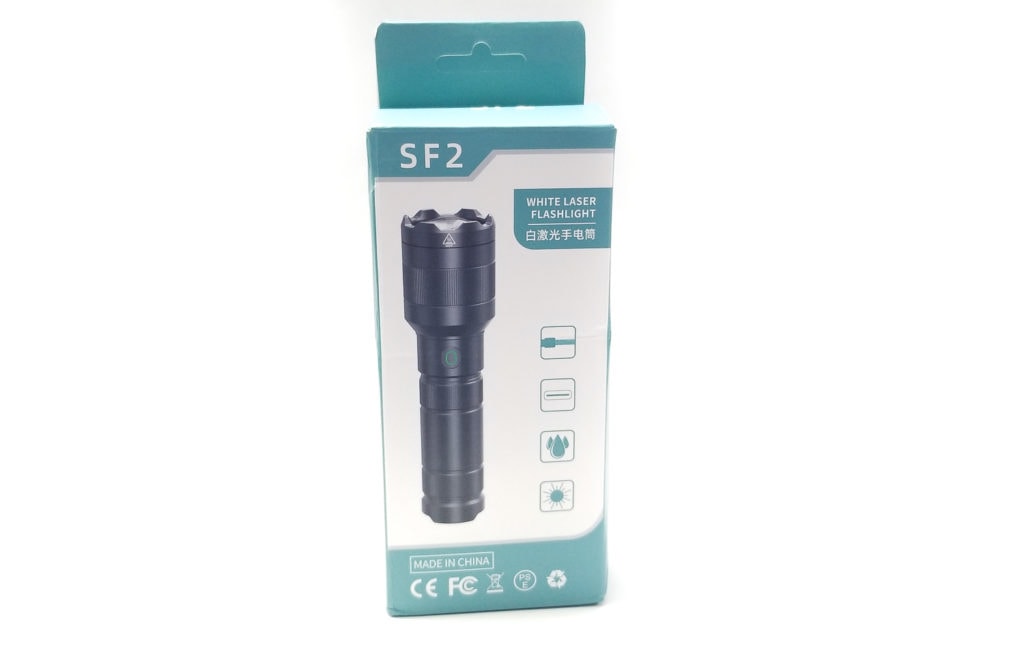
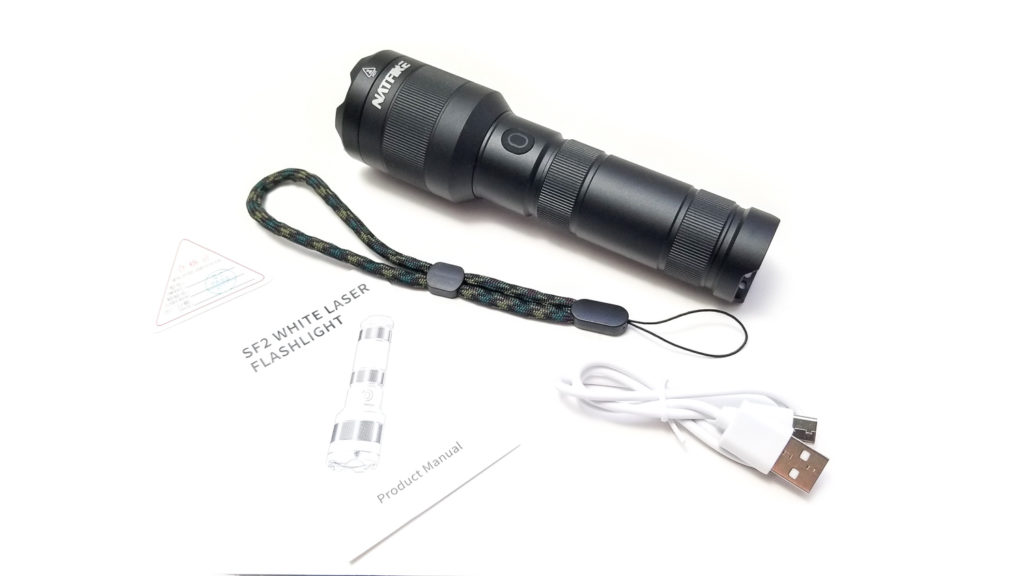
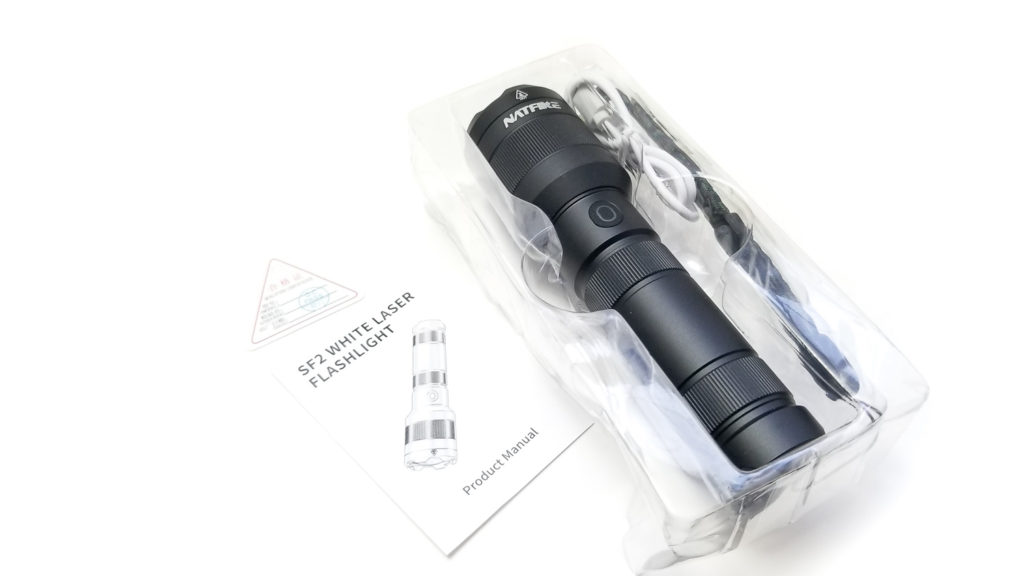
Flashlight in use
The SF2 is an LEP flashlight, and LEPs are good for one thing: Long-distance illumination. Unlike a reflector or optic-based LED thrower, there’s no spill to the beam. It’s all hotspot so it wouldn’t make a good EDC light. If you want a good EDC light, get a Lumintop FWAA. If you want a thrower like a giant laser pointer, grab an LEP. The SF2 is similar in size to my Lumintop D3, and with a 26650 size battery tube (housing a 21700 size battery), it’s a nice size for gripping and fits most hands well. The tube is mostly smooth with only circumferential grooves and some micro grooves reeding on the head, near the tail, and around the switch, so there’s a good amount of gripping surface where needed. It handles nicely in overhand, underhand use, and points naturally. No issues with the balance either, and it’s relatively lightweight even with the built-in battery.
There’s a single ovoid-shaped e-switch behind the head, and it’s not the greatest. It has a soft rubber cover with an LED indicator behind an opaque oval part for operation and battery status. It doesn’t stick up much (if any), and it’s a bit hard to locate by feel in the dark. I found myself pushing the charge port cover more often than not because it feels a bit like the switch. The travel is very short and it takes a bit of effort to press (good for preventing unintentional activation…read on for why that matters), but the clicks are very solid with good tactile feedback. The large charge interface cover is opposite the switch, and it fits securely and pretty flush against the tube. The lift-up tab is positioned vertically not horizontally, so it won’t catch on things and open when being removed from a pocket. There’s no pocket clip, which makes sense because it’s not an EDC or tactical-use light, but it does have lanyard mounting holes on one side of the tailcap (which were big enough for the lanyard to pass through easily…thanks Natfire).

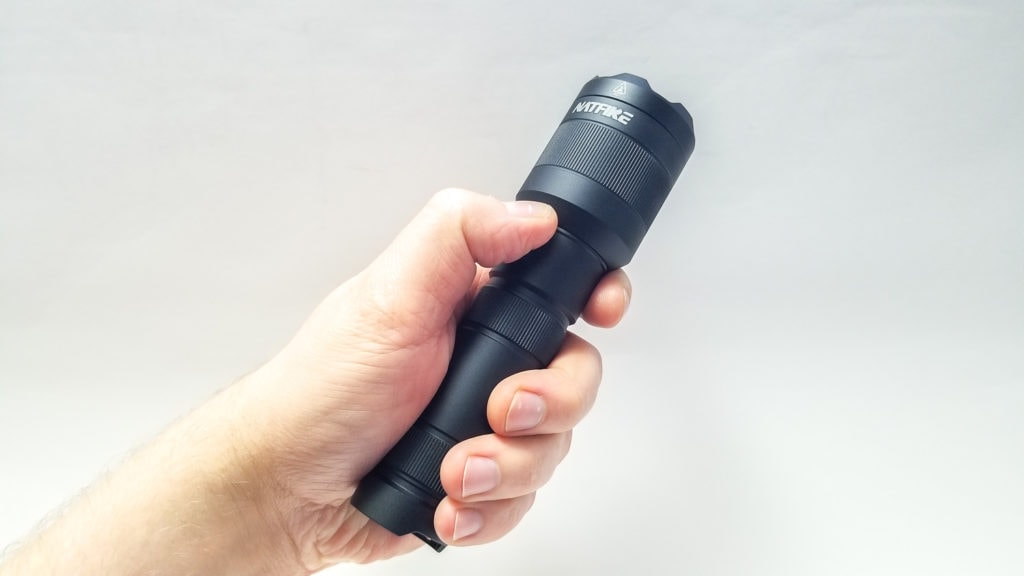
Build Quality, and Warranty
We all know LEPs are expensive, and that’s the main hindrance keeping more enthusiasts from owing one. The first LEP, the Weltool W3, sold for around $350 US, and although the prices have come down a bit, they’re still on the expensive side, with ‘cheap’ ones still north of $100. Here’s where the Natfire shines though, because it sells for around $80 US. Yep, for less than the price of an Olight Warrior Mini 2, you can get yourself a real LEP!
I’m expecting compromises to keep it at that price, and there are some. The light is made from aluminum of some kind, and all things considered, the build quality is really good and it feels solid, about like my Acebeams. It’s hard to see if there’s a seam between the head and body, but it’s there and all it took was some manly grunting and the head unscrewed. It seemed sealed with some weak glue, and there’s no o-ring present, but it looks like there’s a spot for one on the battery tube threads, which are pretty fine pitch triangular cut. (yep, glue’s probably cheaper than an o-ring). I think that’s fine though, since it’s not meant to be disassembled. Once the head’s unscrewed, you can access the battery, electronics and the retaining ring holding in the LEP module. I didn’t try to remove the LEP module, but the driver “cartridge” slides out with the battery in tow, after pulling off the charge port cover. The battery connects to the driver through a micro-pitch 2-pin JST connector, and the LEP is connected to the driver with typical red/black 22 AWG silicone wires. This setup seems more complicated than a traditional flashlight setup, which has the current path in the body, but maybe it’s easier to assemble? This isn’t a low-resistance current path either. The battery lead wires are tiny, probably 28 AWG, and probably add a bit of resistance. Overall, if you wanted, you could swap the battery and maybe repair some things, but otherwise I’d recommend not taking your SF2 apart for fun since it was tricky to get back together.
Moving along, the machining is really tidy and the unspecified HA anodizing is a matte black, and it’s really grippy and nicely-done without any flaws or trouble-spots. There’s no sharp edges or burrs either, which is very nice at this price point. The bezel is removable, and you can remove the plastic aspheric lens, which has a single o-ring for sealing. The LEP module is easily accessed, and it’s screwed-in, but that’s as far as I wanted to disassemble it. The battery is built-in (well, almost) so there’s no tailcap to remove, and the charge port is nicely sealed. However, all this only amounts to an IPX5 rating, and although the product ad says the SF2 isn’t afraid of heat or cold, it probably shouldn’t go swimming since the IP rating is limited to light splashes of water.
Warranty? Well, sort of. It’s not as good as a mainstream brand, which makes sense given the low price point. Returns are handled through AliExpress on the Natfire store, and here’s what Natfire has to say about that: No reason to return goods within 15 days. This warranty don’t fit damage caused by accident, misuse, or modification. Only the parcel without personal error use or damage which not affect the second-sales of the parcel. You can send item for repairing within 1year after receipt. Shipping cost on buyer side.
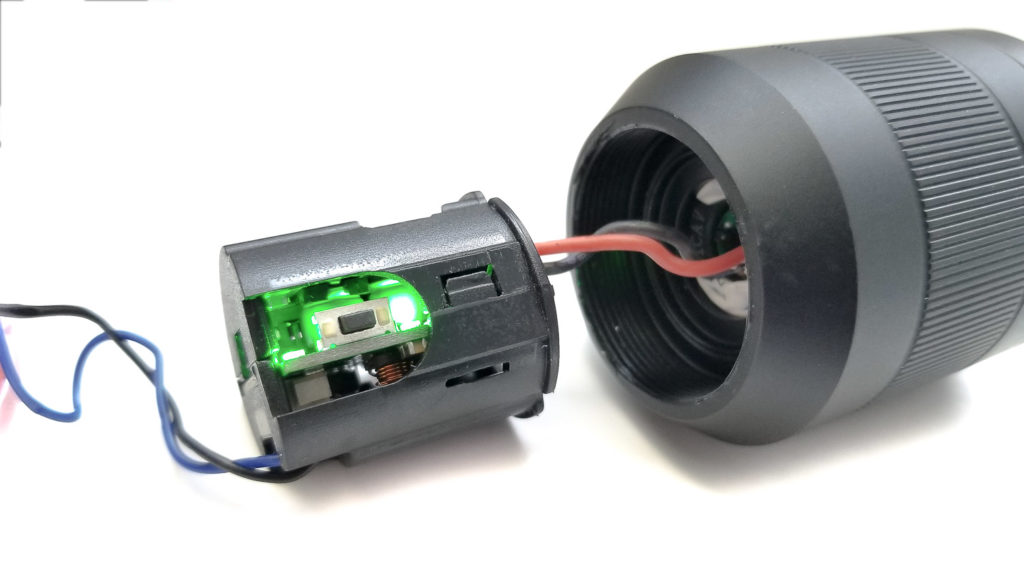
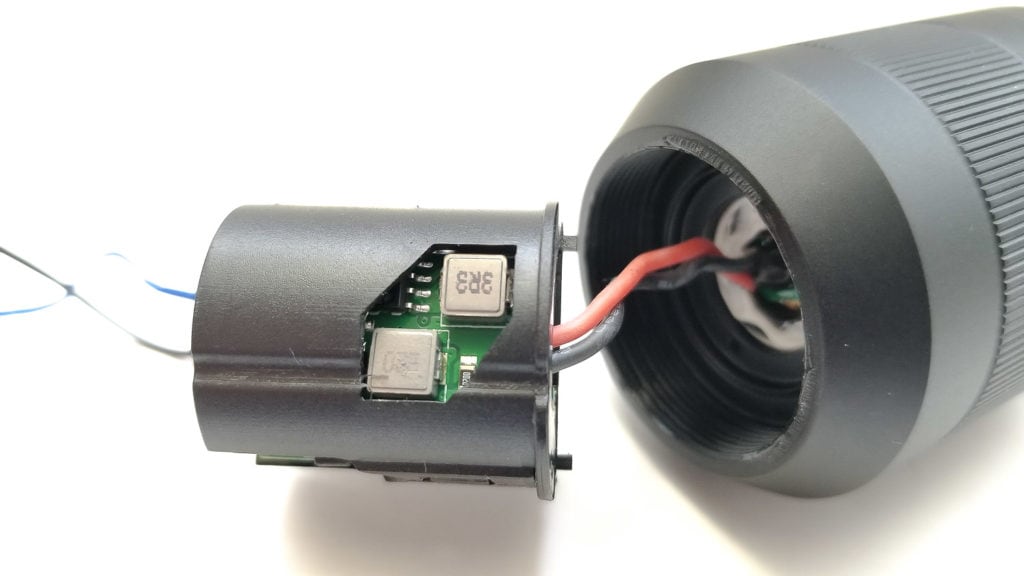
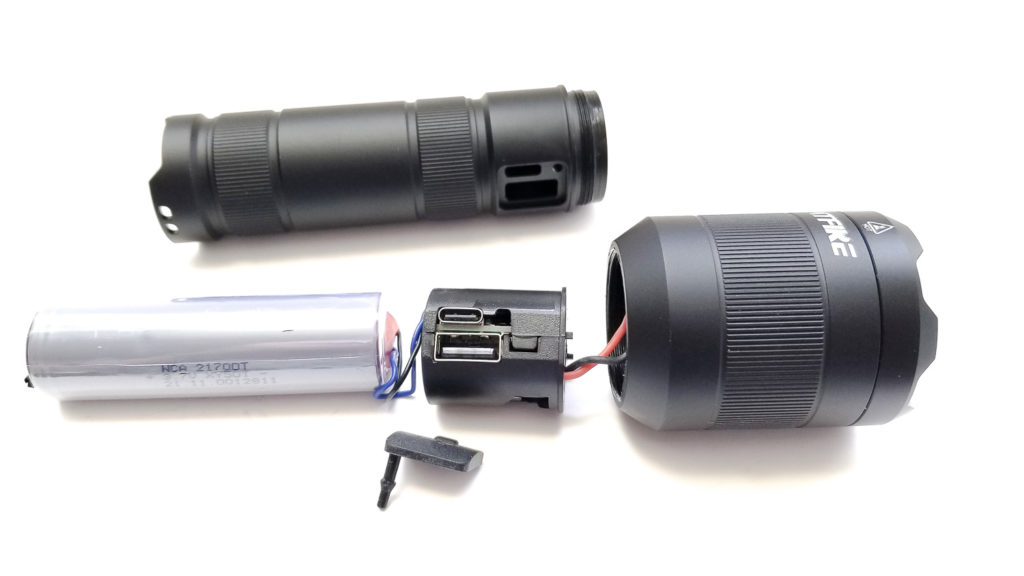
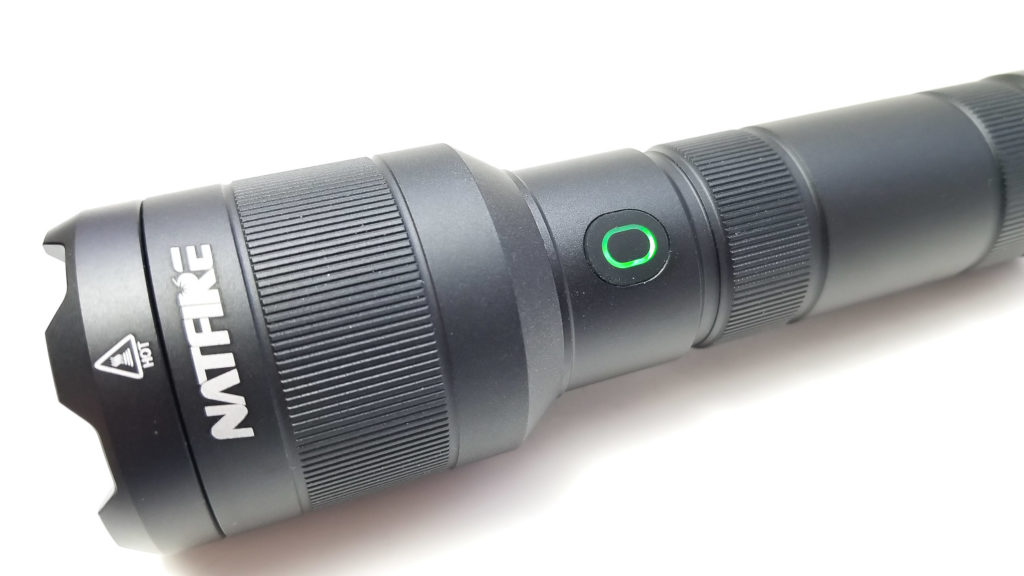
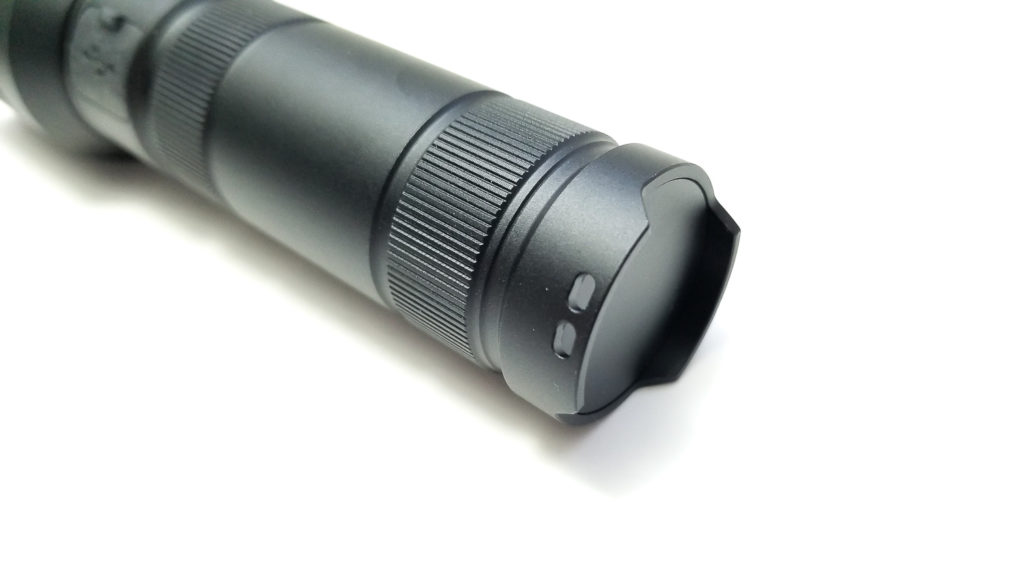
LEP, Lens, Bezel, Beam, and Reflector
We’re dealing with an LEP, not an LED, so if you’re wondering what that fancy acronym entails, here’s a bit of history. The LEP (laser excited phosphor) light source was developed by China’s Tsinguha University photonics and electronics department as an alternative light source for car headlamps and directional lighting. It was a success and currently, LEP sources come in two types: the shine-through (backlit), and older mirror-type. Each has their differences, but both work by passing light from a pumped blue laser diode through a substrate coated with phosphor material to change the blue light to a yellowish/blue-white color. This light is then passed through a series of focusing and collimating lenses to create a uniform, flashlight-like beam. The beam is very focused and laser-like with zero spill or side illumination. The main advantage is long-distance observing and spotting without any distracting spill. However, the LEP comes with a significant Lumen deficit just like a zoomie in spot mode.
The SF2 features the newer-type backlit LEP module. The bezel is a crenulated aluminum unit that seems pretty light duty. It does extend a bit over the top edge of the aspheric lens, but not by much. This is an issue because the lens is not protected by a glass lens, so be careful because the lens scratches really easily. My sample was already very lightly scratched out of the box, and if you break the lens or damage it, you can’t use an off-the-self aspheric lens since this one is specially designed for an LEP.
The beam is typical LEP, thin with no discernable spill and an intense hotspot, which is great for throw. The hotspot up close is very bright and serves to add some splash illumination from the reflection, but otherwise, there’s nearly no side illumination. Unlike an LED, there’s no tint, binning, CCT, CRI, Ra, nada, so If you identify as a tint aficionado and demand pristine tint uniformity with high CRI, you probably won’t like an LEP. With the SF2, you sort of get what you get for beam tint, but for a sub-$100 LEP, the tint is impressively good, with a blueish-white color that’s not at all unpleasant, with only a bit of purple corona around the hotspot.
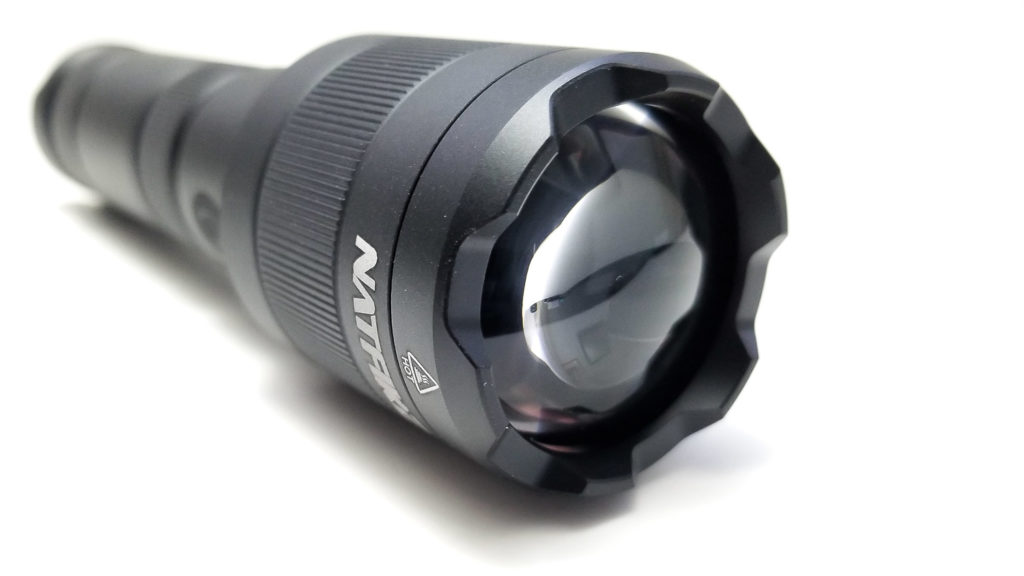
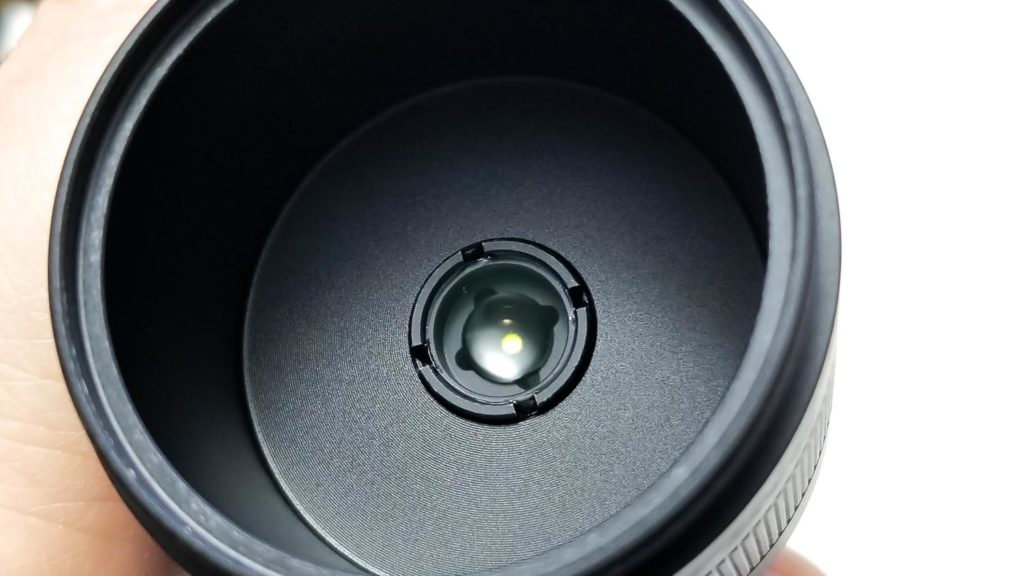
Dimensions and size comparison
Length:
- Length: 15.6 cm / 6.14 inches
- Head diameter: 4.3 cm / 1.69 inches
- Body diameter: 3.1 cm / 1.22 inches
Weight:
- With built-in battery: 249 grams / 8.78 oz.
Natfire SF2 Flashlight comparison
I compared the SF2 to some other long-throwing flashlights I own. The SF2 is about the same size as a C8 style light, and closer in size to the Cyansky K3.
Group 1 left to right: Convoy L21B, Speras T3R, Acebeam L19, Natfire SF2, Acebeam L18
Group 2 left to right: Astrolux EC03, Fireflies E07 2021, Thorfire C8, Natfire SF2, Sofirn SC31T, Lumintop D3
Group 3 left to right: Natfire SF2, WildTrail WT90
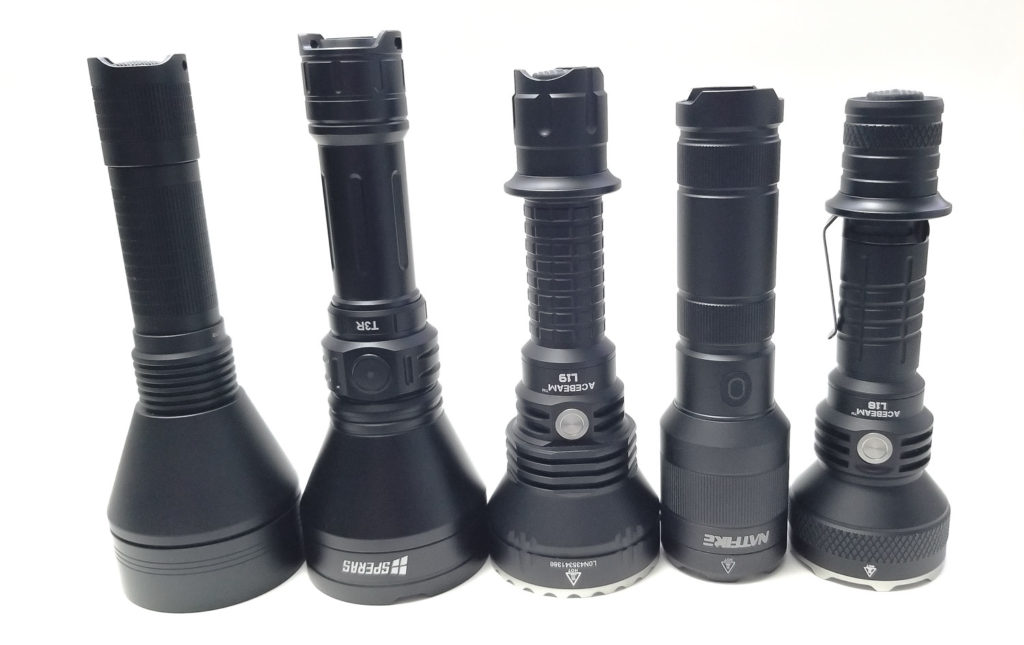
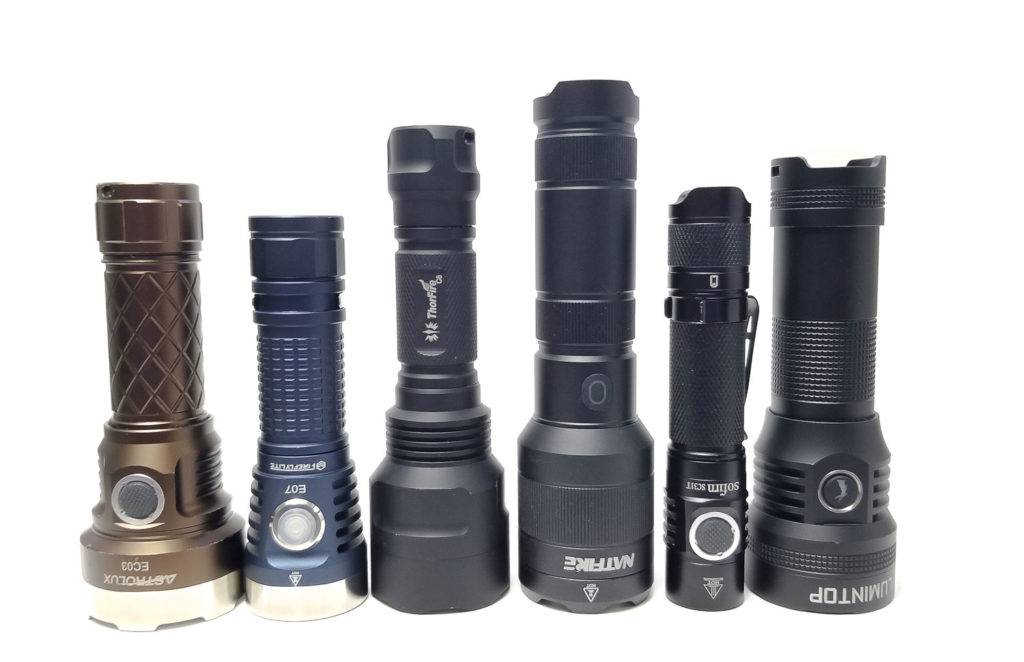

Driver & User Interface:
Natfire doesn’t say what driver is in the SF2, but it seems like it may be a buck driver. It’s not attached to the flashlight body, and the current is carried from the battery through lead wires. The driver is a 2-piece arrangement with the LEP driver and charging/powerbank modules connected together. Everything’s encased in a plastic holder that’s held together with clips.
Okay, on to the elephant in the room here: The UI, and to be honest, it’s not good. Not because it doesn’t work, but because it seems like Natfire lifted it from one of those $5 eBay zoomies. The UI consists of 3 regular modes plus a Strobe and S.O.S. It’s a single click for on, press and hold for off, and does have mode memory, but it always starts on High if you cycle through the modes because it turns off after cycling past S.O.S. There is a hidden single mode available though, so that’s a good thing. Rapidly clicking doesn’t do anything either, just switches through modes quickly.
Available modes: High, Medium, Low, Strobe, S.O.S.
From OFF:
- Press and hold: After about 3 seconds, turns on and switches to the High mode only setting
- Single click: Turns on
- Double click: N/A
From ON:
- Press and hold: Turns off
- Single click: Cycles through modes E-L-M-H-E
- Double click: N/A
Mode memory:
- Yes, remembers the last used mode when switched off, even Strobe and S.O.S are memorized.
Shortcuts:
- Press and hold for about 3 seconds from off to activate the single High mode.
Low voltage warning:
The switch LED shows battery state during operation:
Green for 100% to<30%. For 30% or less, the switch will turn red. I did notice the switch started blinking red only about 30 minutes into the High mode test, and about 3 hours into the Medium test. There is no visual LVP warning though.
Strobe/blinkies
- Yes, Strobe and S.O.S.
Lock-out mode:
- Nope
PWM
- None and not visible by camera
Additional info on the UI:
- A couple things. Yah, the UI is a bit rubbish, but it’s not terrible. Natfire did help its cause a bit with the single High mode setting and mode memory, but I could do without press and hold for off, no lockout, and blinkies that are annoyingly part of the mode set. The Amazon Gearlight S1000 has almost the exact same UI (sans the single High mode and memory). It always starts in High, but honestly, I think that’s what mode most users will be using anyway. Natfire says there’s intelligent temperature control built-in as well, and I’m glad to see there’s no PWM.
Batteries & Charging
The Natfire SF2 features a built-in 5000 mAh 21700 size battery. Now, we all know built-in batteries can be good or bad, depending on your preference, but for enthusiasts, this is less desirable. When the battery goes flat or fails, you either recycle the light or send it back for a new battery. However, the battery can be accessed, but I imagine it’s not recommended to do so. Replacing the battery would be tricky as well, because the cell has spot-welded tabs for the positive and negative leads that terminate in an HST connector, so if you replace the battery, you’ll need to add tabs or buy one with tabs installed. The battery is the excellent Panasonic NCR21700T, also known as the “Tesla” cell. Nominal capacity is 4800 mAh, and it’s nice to see a quality battery here. It’s comparable to a Samsung 50E3 and should be more than enough to supply the LEP module and power bank.
Natfire also added USB type C onboard charging, set at 1 amp max charge rate, which is pretty dismal given this is sporting a 5 Ah battery. I measured it at 1.02 A on my USB tester, so plan on waiting a while…do a puzzle, watch grass grow (or reruns of Teenage Mutant Ninja Turtles), what have you since it’s about 4.5 hours for a full charge. Kind of a bummer when there are cheaper lights sporting 2 A charging, but remember, we’re cutting costs.
Edit: 2023-05: I (Marco) measured 4 hours and 46 minutes. The last 1 hour or so, it was charging below 300mA.. which is quite annoying to wait for. Max charge current I saw was also about 1Amps.
Sweetening the deal a bit is the addition of power bank capability. It’s built into the light, and features a USB type A port for plugging in a USB cable. It’s also rated at 1 A discharge, and I saw 0.9 A when charging my Sofirn SP36 Pro Anduril2, which is pretty good. Again, not fast charging by any means, but good enough.
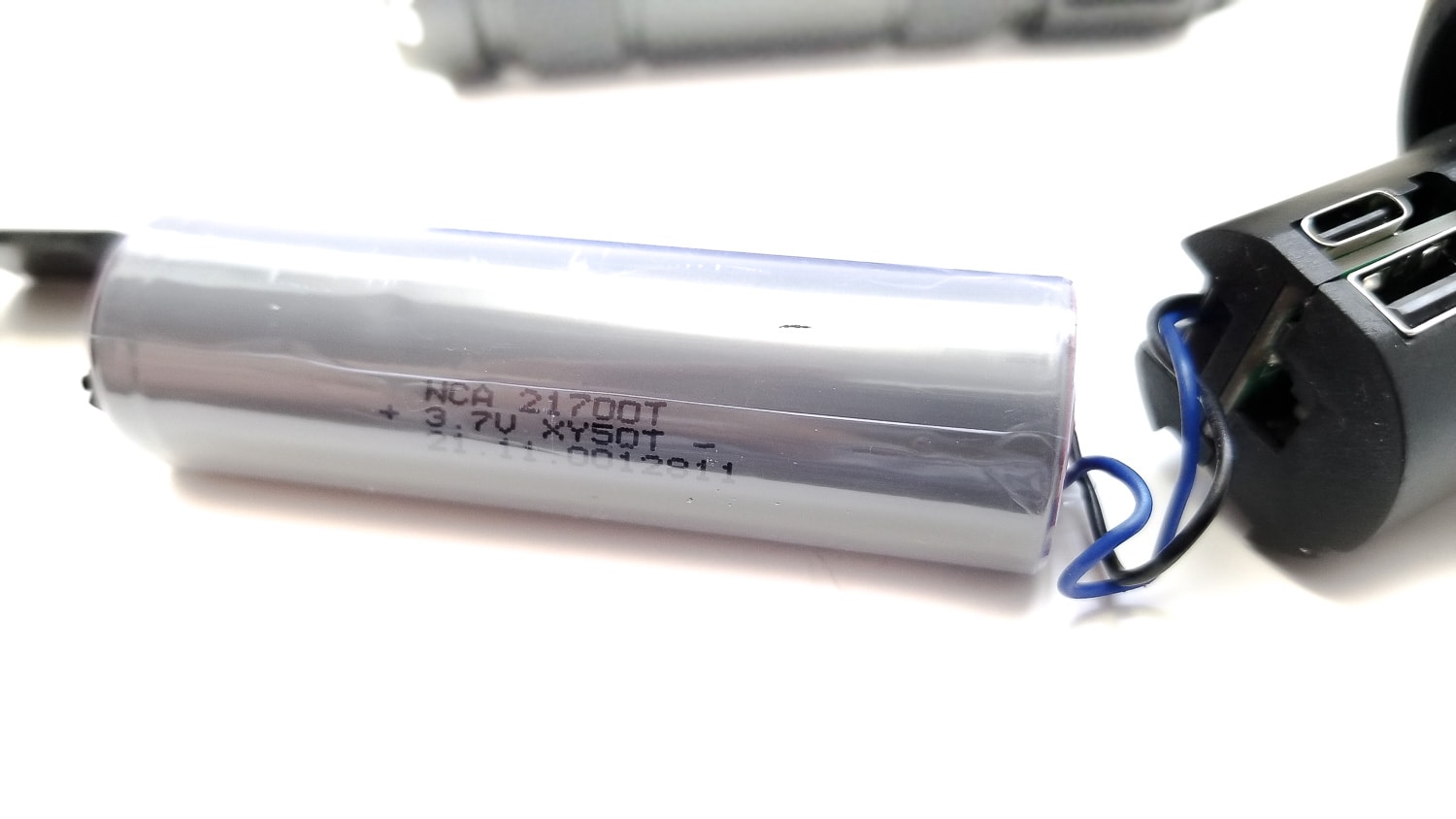
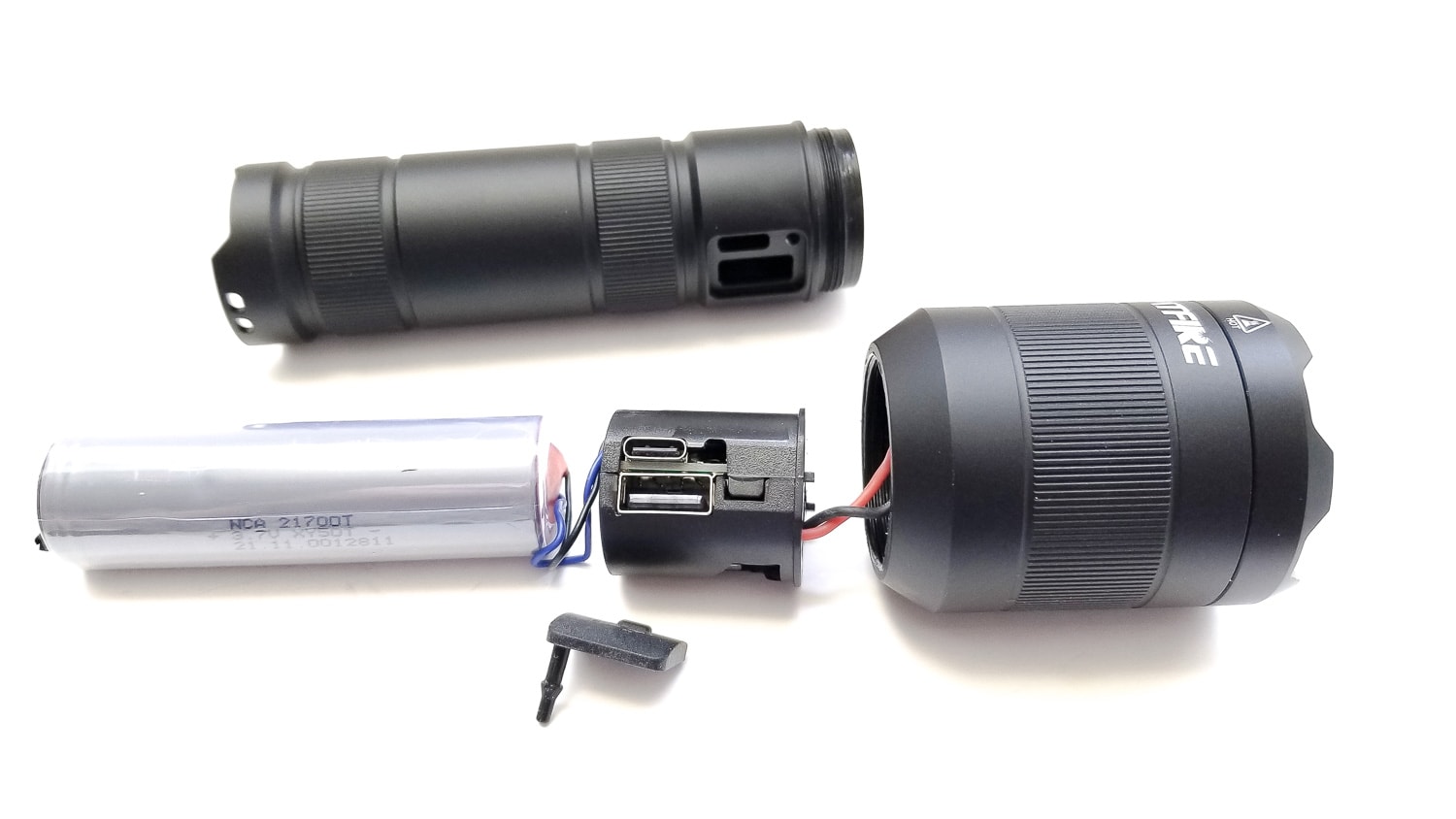

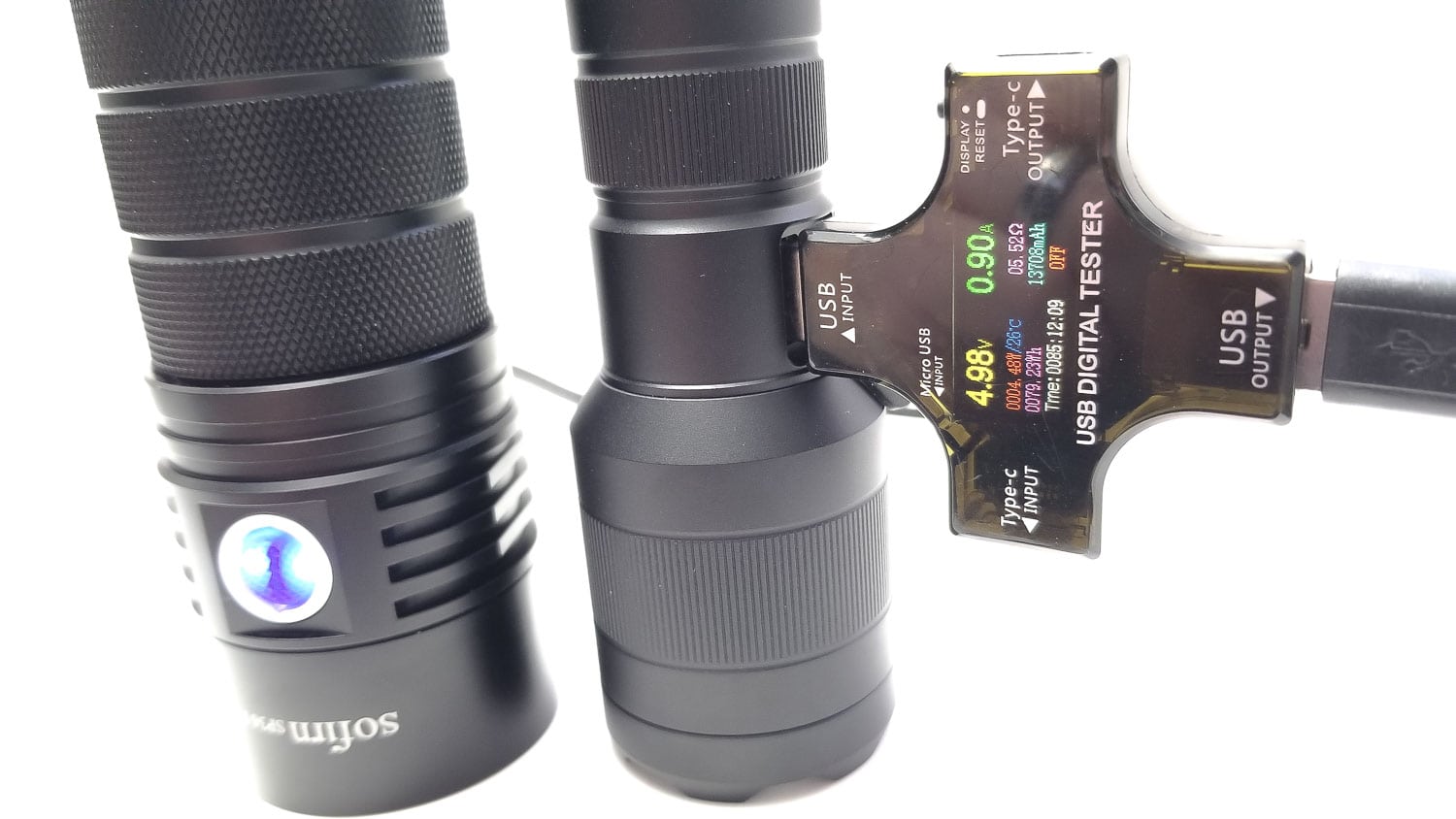
Performance test
Lumen measurements:
Lumens are measured using my home made 30 cm integrating sphere, and I use a Digi-Sense 20250-00 datalogging luxmeter. The sphere has been calibrated using many lights of known output, including a Makkua calibrated Convoy S2+. All measurements taken at 30 seconds with the fully charged internal battery. I took the risk and tore the SF2 down to get to the otherwise inaccessible current path. This is a decidedly-low current application.
| Mode | Amps at start | Specs | turn on | 30 sec | 10 minutes |
|---|---|---|---|---|---|
| Low | 630 mA | ? | 52 lm | 52 lm | 47 lm |
| Med | 950 mA | ? | 95 lm | 92 lm | 89 lm |
| High | 1.77 A | ? | 186 lm | 183 lm | 181 lm |
The numbers might seem really low, but that’s typical and expected with LEPs. Natfire doesn’t list Lumen specs for the SF2, and that’s fine. Getting a parasitic drain reading would have meant cutting the battery wire, and I didn’t want to do that.
Edit 2023-05: I (Marco) also tested my copy and here are my measurements. Done in an homemade integrating sphere (50cm), with Extech SDL400 luxmeter, and Kenko PRO1d ND16 filter. Only measured manually at turn on and 30 seconds. I also measured High at 60 seconds to see if it had a stable output. The numbers are slightly different from Nick’s readings, but they aren’t far off, except for High mode.. Mine measured much lower than Nick’s.
| Mode | Specs | At turn on | 30sec |
|---|---|---|---|
| Low | ? | 49 lm | 48 lm |
| Med | ? | 93 lm | 88v |
| High | ? | 124 lm | 133 lm |
Parasitic drain:
- N/A couldn’t measure
Runtime graph
I tested the runtimes in the 30 cm integrating sphere using the Digi-Sense 20250-00 datalogging luxmeter with the fully charged internal battery. I tested Low, Medium and High modes.

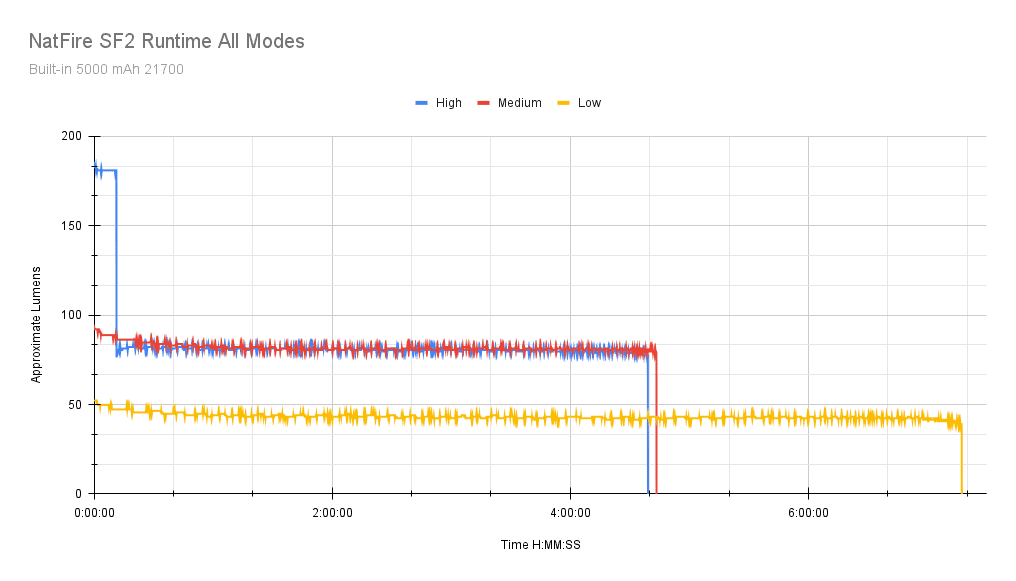
High started at 185 Lumens and held better than 180 Lumens for quite a long time, dropping quite abruptly at 11 minutes down to 76 Lumens, then a slight ramp-up to 82 Lumens about 30 seconds later. This is quite a drop, about 50%, and while that might not seem like much, when you’re dealing with barely 200 Lumens to begin with, it’s quite a bit. The output was pretty steady for the next 3 hours and 28 minutes until a very abrupt shut down at 4 hours 39 minutes. There wasn’t any LVP warning other than the blinking switch LED (twice every 4 seconds or so). The light wasn’t usable after the test, save for 3 second bursts before it shuts down. I measured a max temperature of 38 C at 30 minutes in, and it was always relatively cool to the touch. It didn’t heat up very fast either, only rising 10 C in almost 10 minutes.
Medium was rock-solid with excellent regulation and sustainability, but then again, this isn’t a hotrod EDC or high-power light. The test stated at a bit over 90 Lumens, and like High, the output didn’t drop too much over the entirety of the runtime, only stepping down to 79 Lumens at the 4 hour 38 minute mark, with shutdown happening at 4 hours 43 minutes. The shutdown was abrupt, with only the blinking switch LED to warn you that anything was awry. Temperatures were completely manageable, never going over 33 C from an ambient of 23 C.
Low was unbelievably boring, but a good excuse to go take something that works perfectly fine apart. The test started at 52.9 Lumens, and the output didn’t drop much, dipping below 50 Lumens by about 2 minutes in. It didn’t drop below 40 Lumens until 7 hours 13 minutes in, and never dropped below 39 Lumens for the entirety of the test. The light shut down (abruptly again) at 7 hours 17 minutes. Again, no warning of the impending shutdown aside from a blinking red switch indicator. The temperature never crested 30 C the entire test.
Overall, this is very good performance and indicative of a constant current driver, which is nice. We’re seeing nice flat runtime graphs for all modes without much drama with thermal regulation. It works seamlessly, but we can see a bit of anomalous noise in the graphs, and that may be due to the sensor picking up some shimmering in the output, which I noticed during the Low and Medium tests. It’s not super-visible and unless you’re shining it on a white wall (or staring into an integrating device), you may not notice it. It’s not PWM, but almost like a bad battery or electrical connection. Although the NatFire SF2 will mostly be used in High mode anyway, nonetheless, it is there. It’s kind of a bummer, but not super-surprising on a cheap LEP.
Throw numbers:
Throw was measured using the Uni-T 383S luxmeter at 10 meters outdoors. Readings taken at 30 seconds. The internal battery was fully charged.
| Mode | Specs | Candela measured | Meters | Yards |
|---|---|---|---|---|
| Low | ? | 156,500 cd | 791 | 865 |
| Medium | ? | 245,100 cd | 990 | 1,083 |
| High | 562,500 cd (1500m) | 537,900 cd | 1,466 | 1,603 |
NatFire doesn’t list throw specs, other than “1000-1500m irradiation distance” per the ad. I have to say these are more than respectable throw figures for a low-cost LEP, beating the much more expensive Nextorch T10L, Fenix TK30, Weltool W3 Pro, and ‘budget’ Lumintop Thor I.
Edit: Marco also tested this light, and got the following measurements:
| Mode | Specs | Candelas measured | Meters | Yards |
|---|---|---|---|---|
| Low | – | 147,200 cd | 767 | 839 |
| Med | – | 256,800 cd | 1014 | 1108 |
| High | 562,500 cd | 347,600 cd | 1179 | 1290 |
As you can see, the performance is not similar, not even close. It’s still nice performance, but you don’t know what you get, unless you test it! This is another reason of why you should have a lux meter.
Beamshots
I tested the Natfire SF2 against some long-throw LED flashlights:
- Acebeam L19 (with 60 mm TIR and OSRAM CULPM1.TG 1300 m throw)
- Acebeam L18 (47 mm TIR OSRAM CSLPM1.TG around 1000 m throw)
- Convoy L21B (60 mm reflector SFT-40-W about 1100 m throw)
- Speras T3R (60 mm reflector SFT-40-W, 1000+ meters throw)
- WildTrail WT90 (90 mm reflector SBT90.2), which I measured at a bit over 1700 m throw
The tower is about 950 m away. All of the lights reach the tower, but the Acebeam L19, Natfire, and WT90 easily light it up very well. Very impressive!
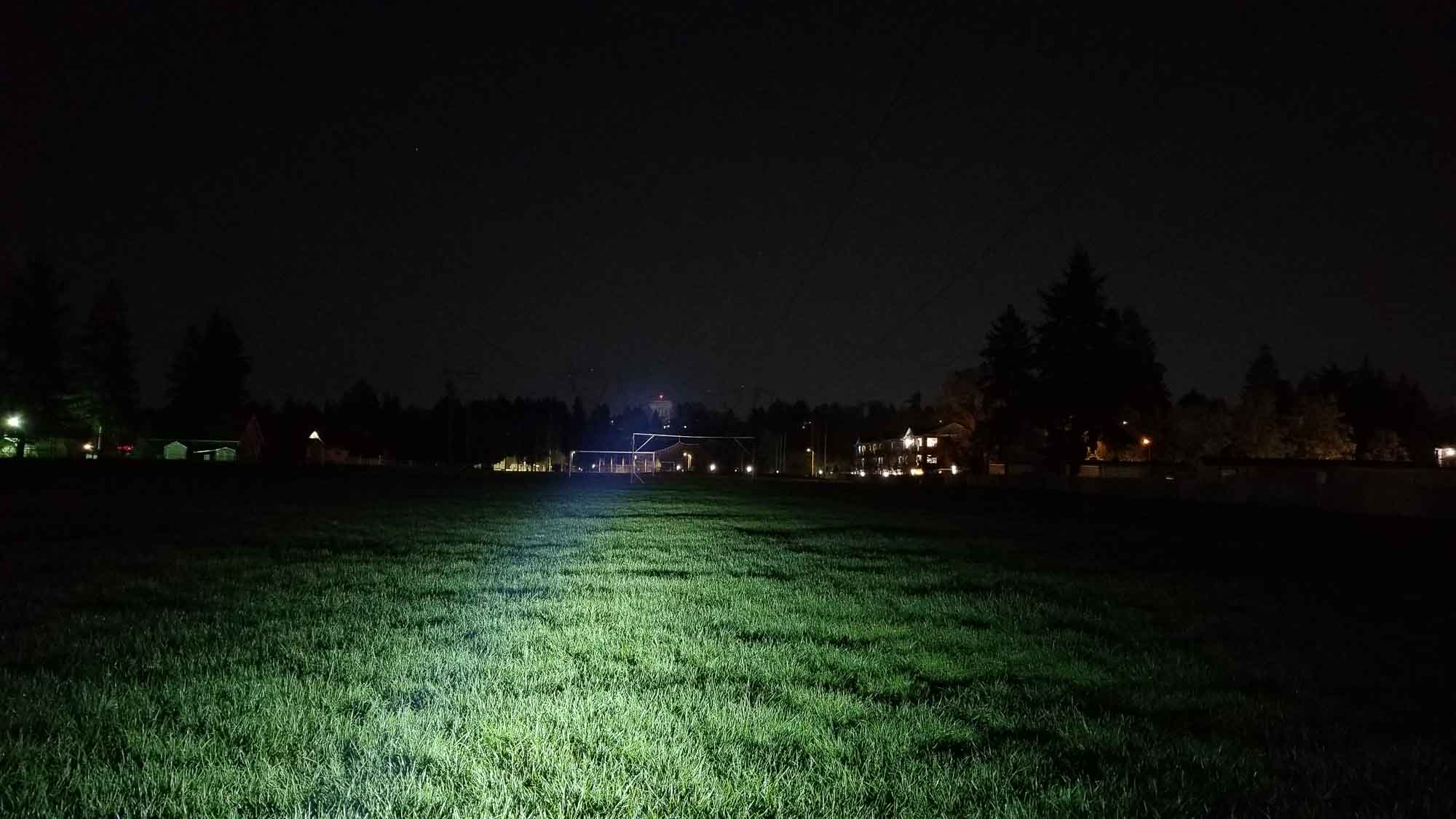
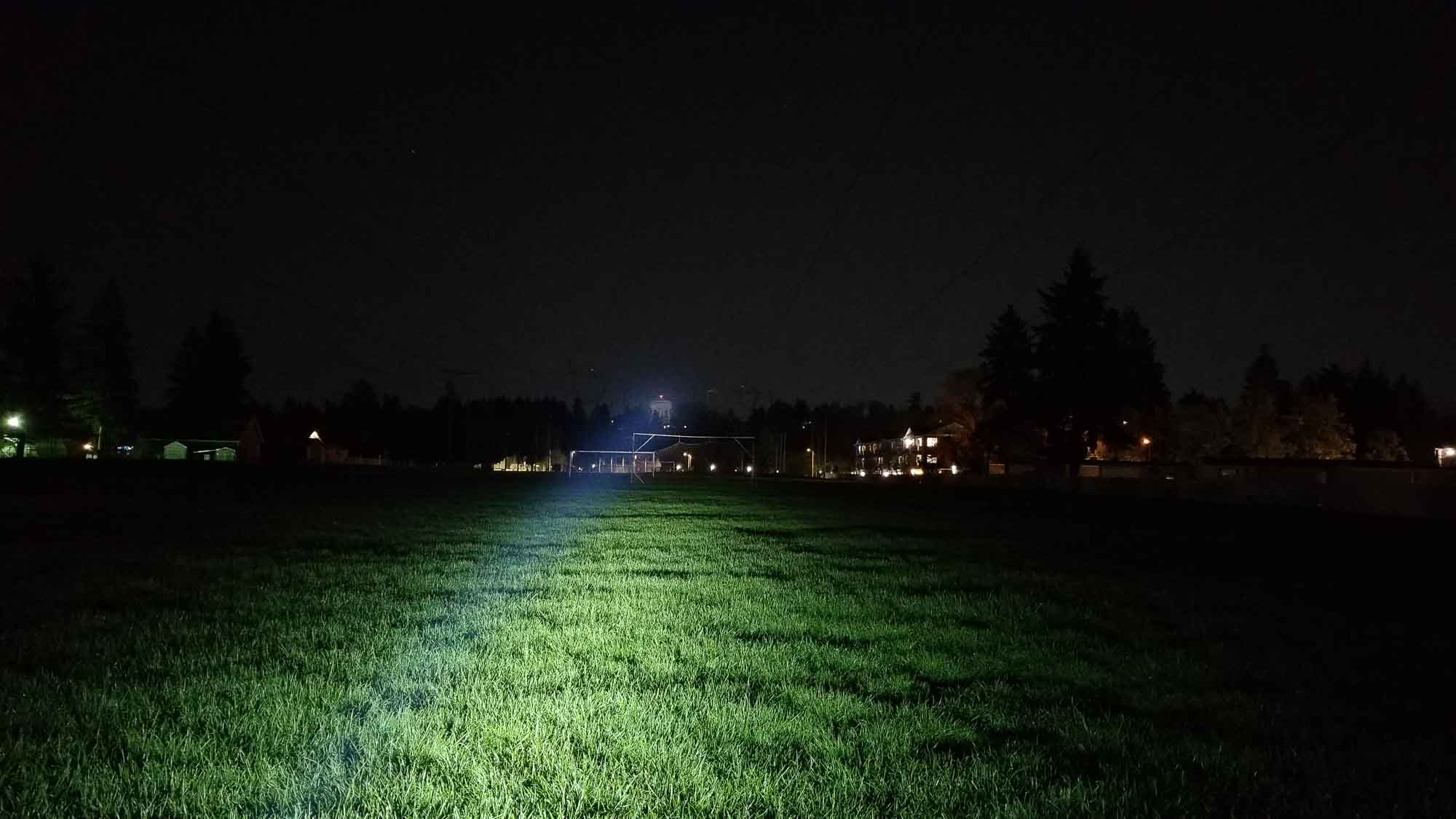
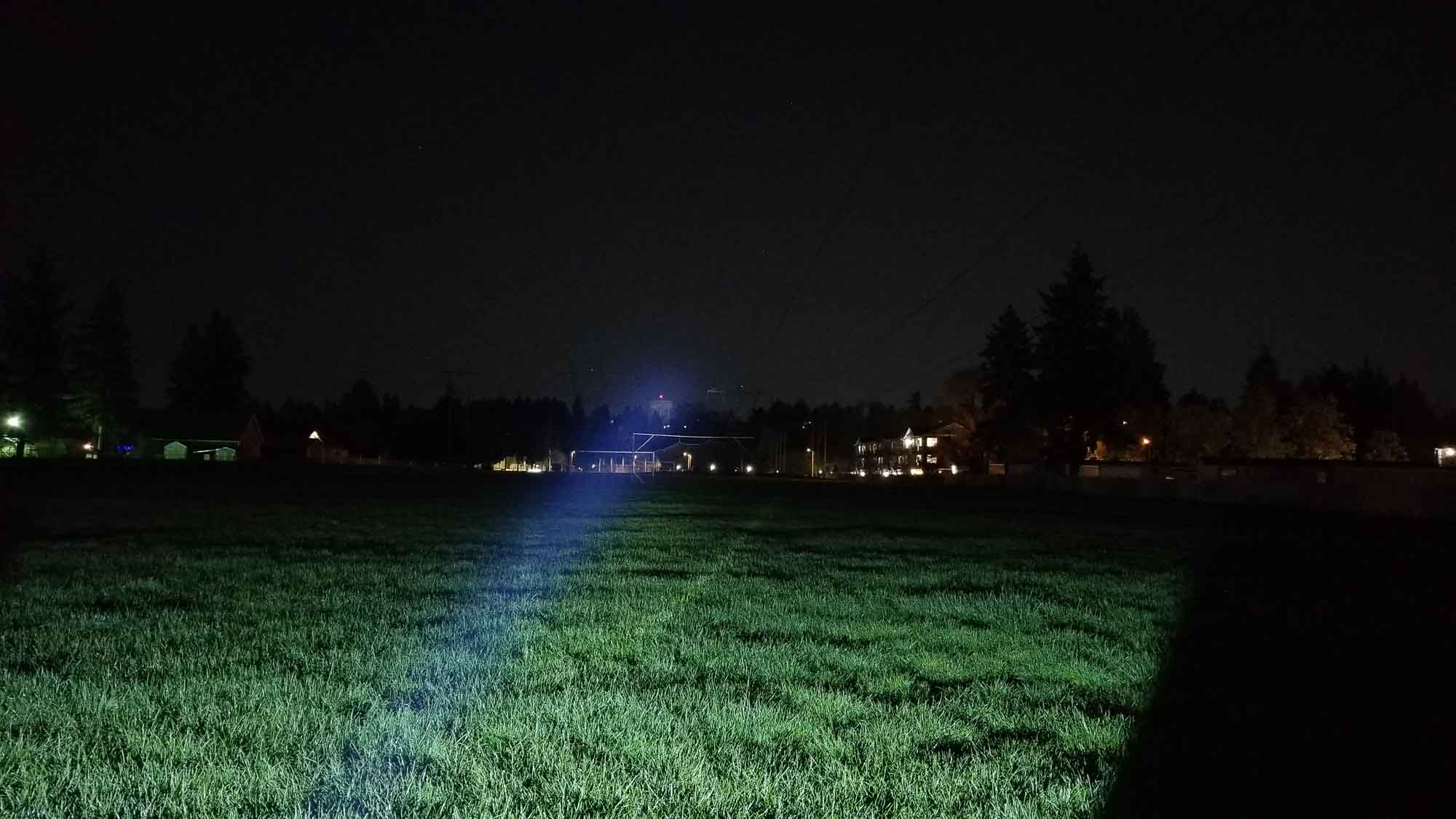
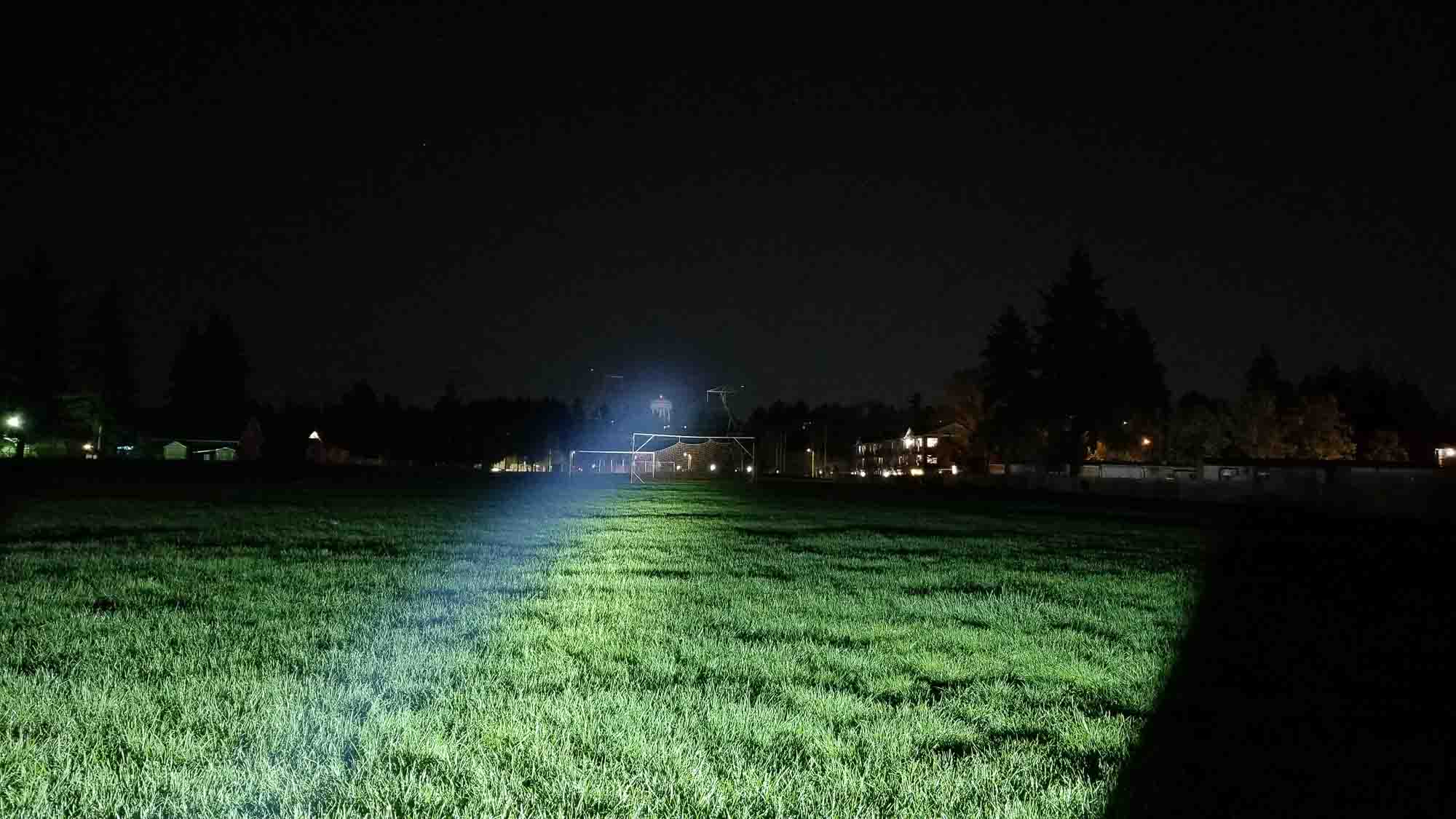
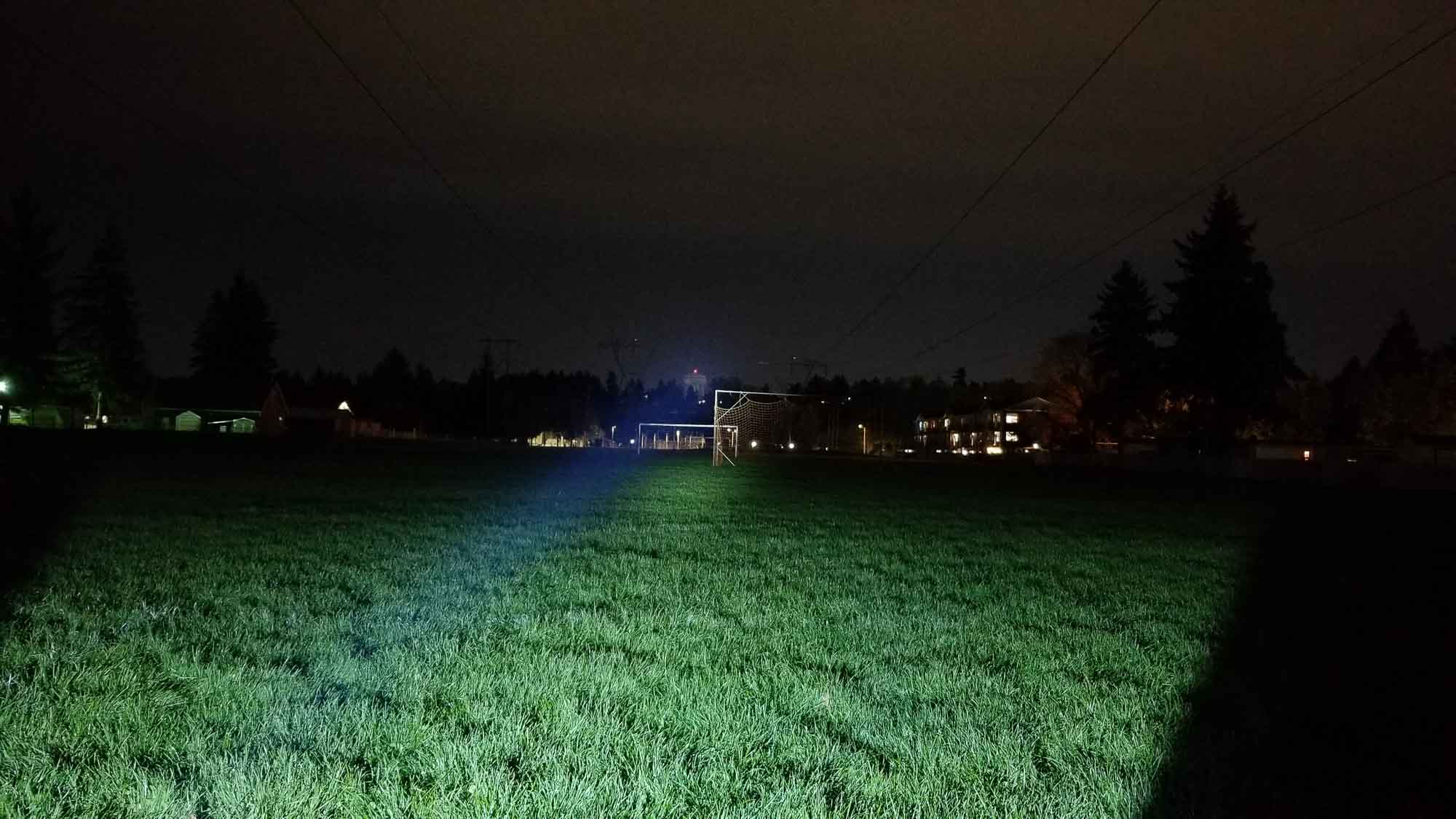
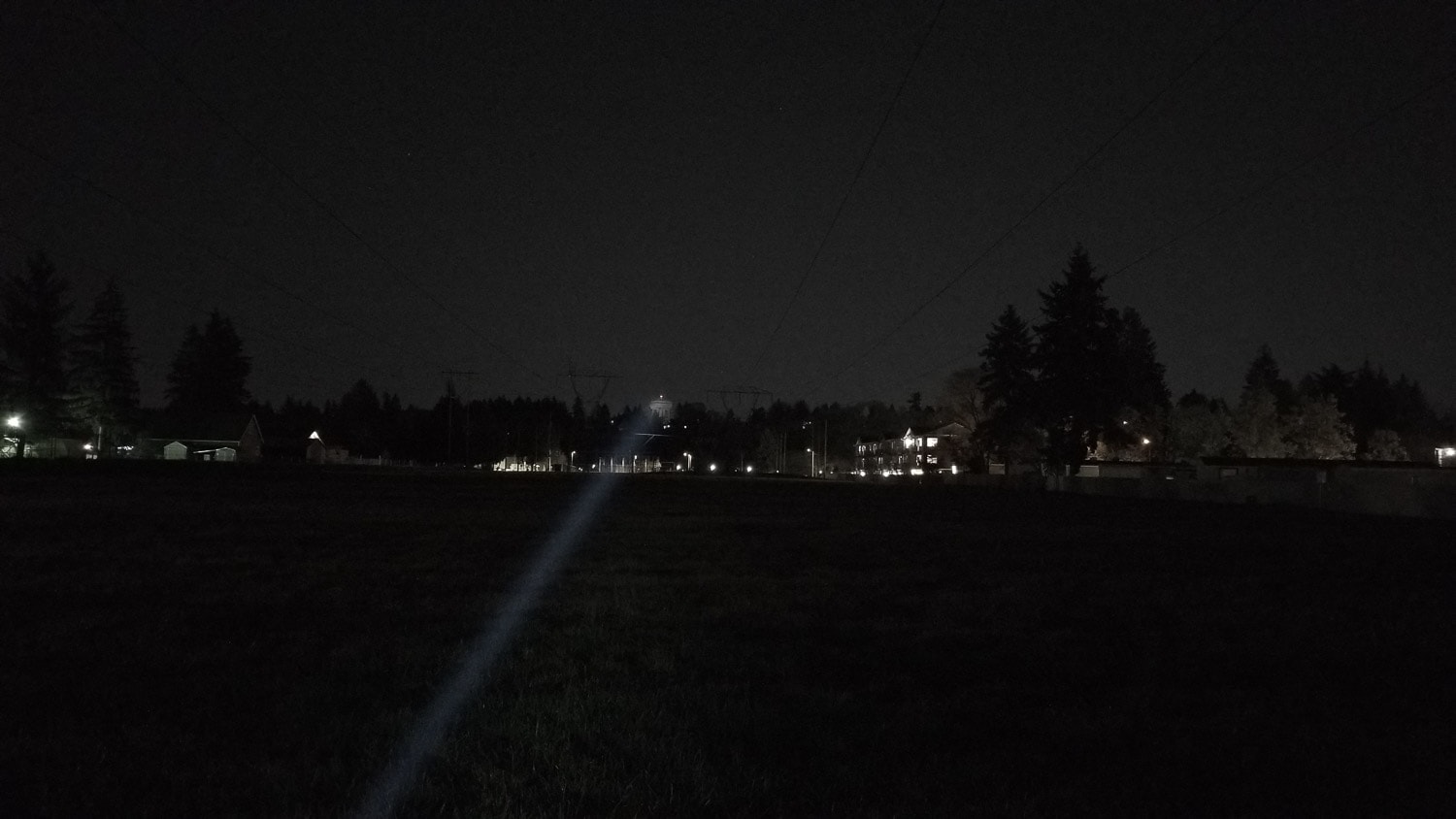
Disclaimer: This flashlight was sent to me for review at no cost by Natfire. I have not been paid to review, nor have I been holding back on problems or defects.
Final Verdict
Pros
- Fantastic value
- Great throw performance
- Clean, nicely-tinted beam
- Solid build quality, fit, and finish
- 5000 mAh battery and power bank
Cons
- Bargain-basement UI
- Plastic lens (without protection lens)
- Shimmering on Medium and Low modes
- Abrupt LVP shutdown
- Ssslloowwww charging
Explanation on star ratings:
1: Avoid: my phone flashlight would be a better choice – 2: Poor: significant defect or issues; almost unusable – 3: Average: some defects or issues; but still usable 4: Good: recommended (minor issues) – 5: Great: highly recommended

4 stars: ★★★★
Until the NatFire SF2 came along, “low-cost” and “LEP” weren’t words you heard used in the same sentence, but here we are, wrapping up a review of a cheap LEP. Not only is it cheap-ish, but it’s a decent light with good performance in the area that appeals to a flashlight enthusiast shopping for an LEP: Throw. It also has some other nice features I wasn’t expecting at this price point. To put the NatFire’s performance-to-dollar ratio in perspective, to get better throw, you’re stepping up to the $160 Nealsgadgets LEP-with-no-name, or the $180 Lumintop Thor II. A comparable, low-price LED flashlight will be a humongous XHP35 HI unit like the Astrolux MF04. The low-price notwithstanding, I’m impressed with this light. It has solid build quality, handles well, and has a clean LEP beam and decent tint. There’s no PWM, and the USB type C charging with power bank output is a nice touch, even at this price.
However, we can’t always have our cake and eat it too, as evidence of cost-cutting to get the price down is evident. The UI seems like it’s been pulled straight from a $5 zoomie, the charging speed is really slow, the aspheric lens is plastic with no protective lens, and I wasn’t fond of the abrupt LVP shutdown either. The shimmering phenomena on Medium and Low mode is annoying, but not a huge issue since most of us will mainly use High mode anyway. Even though the performance is solid, I can’t overlook the other cons here, and that’s why I’m giving it 4 stars. Yah, it’s generous considering the other issues, but the end of the day, the NatFire SF2 is the only decent LEP for sale under $100 currently, and the best option if you want to join the LEP club without having to hawk a family heirloom at the pawn shop or sell your beloved Star Wars action figure collection.
Buy your Natfire SF2 here
1lumen selects and reviews products personally. We may earn affiliate commissions through our links, which help support our testing.